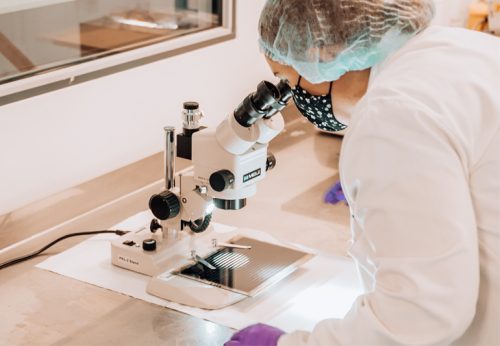
This is a guest blog by: Richard Lewis, Senior Technology Transfer Fellow, SPECIFIC, Swansea University
SPECIFIC is one of seven ‘Innovation and Knowledge Centers’ set up in 2011 to foster new industries by closing the gap between scientific research and commercial exploitation. Richard Lewis, Senior Technology Transfer Fellow at SPECIFIC, Swansea University, highlights that the latest project, aimed at making energy management technology more accessible and affordable, is set to transform sustainability targets for UK SMEs (small and medium-sized enterprises).
What is SPECIFIC?
The goal of SPECIFIC is to aid the development of affordable energy technologies that can be manufactured at scale and reused or recycled at the end of their life.
 Collaborating with enterprise, the public, and the private sector, SPECIFIC explores the application of technology to address everyday problems, conducting tests on materials and products, and validating practical proofs of concept in real-world settings. SPECIFIC is located in the Faculty of Science and Engineering at Swansea University.
Collaborating with enterprise, the public, and the private sector, SPECIFIC explores the application of technology to address everyday problems, conducting tests on materials and products, and validating practical proofs of concept in real-world settings. SPECIFIC is located in the Faculty of Science and Engineering at Swansea University.
One major challenge for UK industry, and the UK more broadly, is energy use and carbon reduction. SPECIFIC wanted to investigate how off-the-shelf technology could deliver valuable insights and performance data to help SMEs better manage their energy costs. Working alongside Cisco, SPECIFIC created a platform to capture parameters such as temperature, humidity, CO2 and light levels, energy usage, and building occupancy. It’s a major step in helping organisations meet sustainability targets.
Why energy management?
Buildings and construction together account for 36 percent of global final energy use and 39 percent of energy-related carbon dioxide (CO2) emissions when upstream power generation is included. We know energy costs are high, and that the UK has some ambitious carbon-reduction targets. This is a major topic for businesses and organisations.
What are you hoping to achieve with this pilot?
We want to demonstrate how easy and affordable it can be to install an effective energy monitoring system into a standard office building. We recognise that building management systems can be expensive and that retrofitting buildings can be disruptive. Many businesses, particularly SMEs, see the cost benefit in reducing energy consumption. They want to hit sustainability targets, but the journey to get there can be daunting.
How are you doing it?
The project is split into three phases: installation of wireless sensors; deployment of network infrastructure; and the creation of a management dashboard. It involves different industry partners – EnOcean and Pressac for the sensors, Cisco for the network, and iSPAYCE from IST for the management platform. The challenge is understanding how best to integrate the different components and one of the aims of this project was to show that it doesn’t have to be complex or costly.
Where is this taking place?
 We’re using one of our own buildings in Baglan, Swansea. It’s a fairly typical office space. We have 18 EnOcean and Pressac sensors across five specifically designated zones spanning two floors within the building. The sensors are battery-powered and maintenance-free; they collect data on temperature, humidity, CO2 levels, motion, brightness, door closure contacts, occupancy, and energy use.
We’re using one of our own buildings in Baglan, Swansea. It’s a fairly typical office space. We have 18 EnOcean and Pressac sensors across five specifically designated zones spanning two floors within the building. The sensors are battery-powered and maintenance-free; they collect data on temperature, humidity, CO2 levels, motion, brightness, door closure contacts, occupancy, and energy use.
What’s Cisco’s role in this?
We have a long-standing and extensive alliance with Cisco, utilising its technology extensively across the Swansea University campus. Over the years, we’ve collaborated on numerous successful projects at SPECIFIC, including high-impact initiatives like Cisco Spaces and building occupancy solutions. Cisco’s enthusiasm for innovation extended to exploring new possibilities. They were keen to leverage their Wi-Fi access points as gateways for various use cases, further enhancing our collaborative efforts and reducing costs for the customer. Therefore, the Wi-Fi access point becomes an IoT gateway.
The EnOcean and Pressac sensors are connected to the Cisco network. Our existing Cisco wireless access points have an embedded IOx edge application for secure tunnelling, which means we don’t need additional gateway equipment. We then use Cisco Catalyst series switching and a virtual Wireless LAN Controller to coordinate the network traffic.
The Cisco network provides seamless data transmission from the wireless sensors to the central monitoring system. We can transmit this encrypted data to multiple partners – data analysts, energy planners, and property managers – and it’s totally agnostic. The current alternative is for organisations to deploy intrusive and expensive sub-meters.
What have been the results?
Firstly, we’ve demonstrated that deployment is straightforward. The sensors were simple to install – peel and stick in some cases. Configuring the sensors on the network added another hour. There’s no need for a retrofit or hard wiring.
We’ve demonstrated you can pull accurate data on a range of environmental parameters. We have a dashboard that displays essential building energy usage and CO2 emissions data in addition to environmental and occupancy data.
And the implications?
To improve energy management, accurate data is essential. Sensors can show the impact of air conditioning units running when they shouldn’t, or the cost of heating a vacant room. Using the approach piloted in this project we can quickly assess the energy efficiency of all kinds of workspaces. You can move the sensors between spaces and very quickly generate a view of a range of environmental parameters. Furthermore, we can connect these sensors securely onto the existing network. This provides us with maximum benefit from the corporate network infrastructure.
“We know business wants to engage on this topic. Energy savings are cost savings.” – Richard Lewis, Senior Technology Transfer Fellow, SPECIFIC, Swansea University

